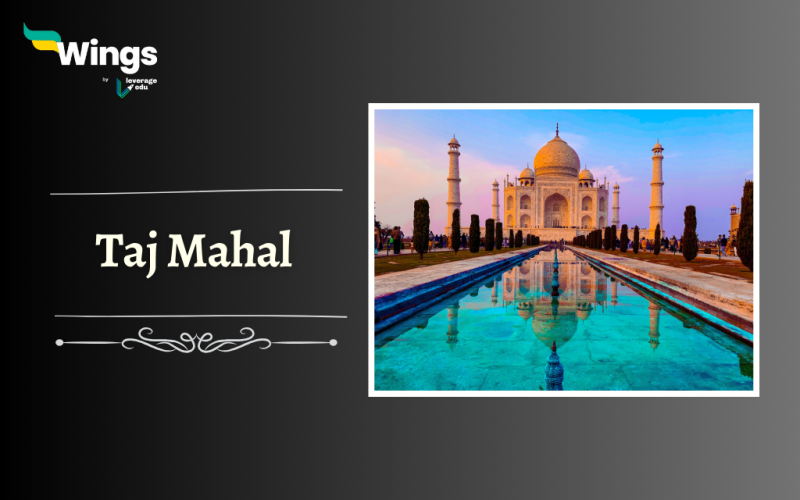The iconic monument that has been a symbol of love for many ages now is actually a mausoleum. It was built in the name of love but today this tomb is world famous and is listed in the UNESCO World Heritage Sites. Moreover, this structure of white marble is an exemplary piece of architecture of Muslim art in India. Every year, around 7 to 8 million people visit the Taj Mahal, out of which 0.8 million are foreign tourists. The Taj Mahal is therefore one of the most cherished pieces of human art created in the history of India.
Table of Contents [show]
Location, Timings & Purpose
The Taj Mahal is located in the Agra district of Uttar Pradesh in India. It is built on the banks of the Yamuna River. Together the river flowing behind the Taj and the monument itself are an epitome of marvel on earth especially on a moonlit night. The Taj Mahal is open for visitors on all weekdays except for Fridays from 6:00 am to 7:00 pm.
It remains closed on Friday for the prayers. The purpose of building the Taj was to cherish the memory of a lover. The Mughal Emperor Shah Jahan built it for his beloved wife Mumtaz Mahal. This is the very place where the two of them were buried after death. The central shrine in the monument is a dummy of their graves which are actually carved in the lower section of the monument, which is not open for public visit.
Also Read: Emperor Akbar: History, Life, Achievements
Who Built the Taj Mahal?
The Taj Mahal was built between 1631 and 1648 by the Mughal ruler Shah Jahan.
- He ordered 20,000 workers to make the grand structure. Other structures like the mosque, the guest house, the outer courtyard, its cloisters mosque and the main gateway were added to the structure in 1653 A.D.
- The structure boasts intricacies and design complications that are unique.
- The chief architect of the monument was Ustad-Ahmad Lahori.
- The emperor had ordered masons, stone-cutters, calligraphers, carvers, painters, inlayers, dome builders and other artisans from around his empire as well as from Central Asia and Persia.
Also Read: Mughal Emperor Jahangir: Life, Legacy, and Influence
Taj Mahal Architecture
There are many popular anecdotes and beliefs about the structure of the Taj Mahal. One of them is that Shah Jahan ordered to cut Ustad Ahmad Lahori’s hands and that’s when the artisan sneaked some time to make a hole somewhere in the roof of the Taj Mahal that makes water drip to the graves whenever it rains. Though no one knows if it’s entirely true.
- What is known though is the existence of several historical and Quranic inscriptions on the walls of the Taj Mahal. Their verses are in Arabic script all over the monument and the main arches of the gates.
- The whole structure has a rhythmic combination of solids and voids, its concave and convex structures play intricately with light and shadow. The most aesthetic visible aspect though are the arches and domes.
- The stonework of precious gems in vibrant green, red and blue over the white marble canvas make Taj the best architectural marvel of this time.
- Dome of the Mahal is situated at the end of the quadripartite garden to give it more depth. The roof of the dome also has metal rings for earthing in case lightning strikes the building.
Overall the minarets, garden and every other structure on its premises are wonderfully planned to give it an out-of-the-world look and feel. It also provides unique features like safety from earthquakes, lightning and floods.
Also Read: Babur: The Magnificent History of the First Mughal Emperor
Black Taj Mahal
The Black Taj Mahal was planned to be built across the Yamuna facing the Taj Mahal. It was also planned by Shah Jahan and is often referred to as ‘Kala Taj’. He wanted it to be his own mausoleum. A French traveller Jean Baptiste Tavernier was the first one to mention the Black Taj in his writings.
He described it as a mausoleum for Shah Jahan that he was building for himself but couldn’t complete it. Before he could start work on the Black Taj Mahal he was confined by his own son Aurangzeb. However, the Black Taj Mahal is still considered a myth as no proper evidence of it was found.

However, in the 1990s some discoloured white rocks were discovered by archaeologists that had turned black, but this was not evidence enough to conclude anything. There is a more popular theory around it discovered in 2006 where the Black Taj Mahal was seen as an idea rather than a structure. Archaeologists reconstructed the pool in Mehtab Bagh at that time.
They found a dark reflection of the Taj Mahal clearly forming in the waters of the pool. The positioning of the pool as well as the emperor’s obsession with symmetry validates this theory to a better level than the previous level.
Relevant Blogs
That’s all about the Taj Mahal! If you want to know more about topics like this, then visit our general knowledge page! Alternatively, you can also read our blog on general knowledge for competitive exams!
 One app for all your study abroad needs
One app for all your study abroad needs















 45,000+ students trusted us with their dreams. Take the first step today!
45,000+ students trusted us with their dreams. Take the first step today!
